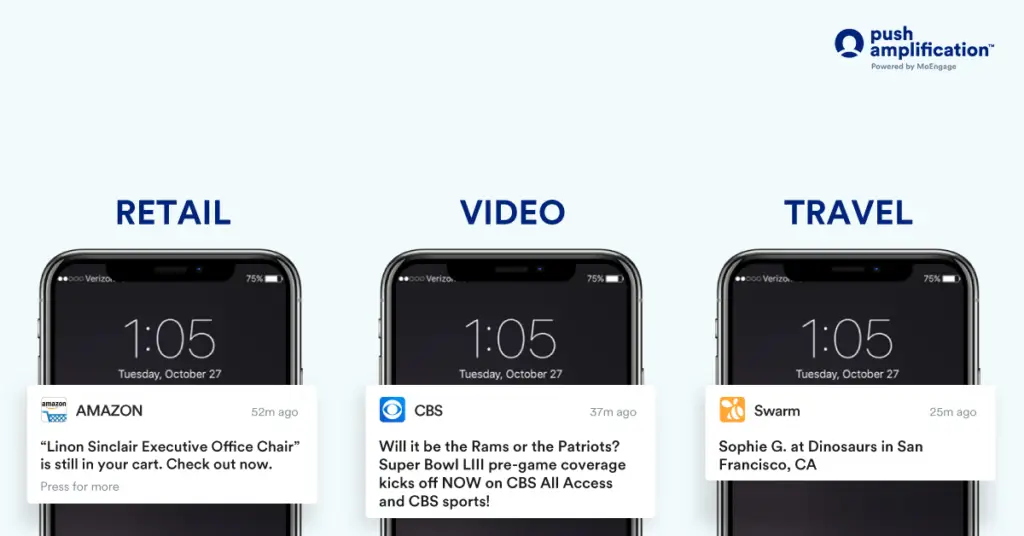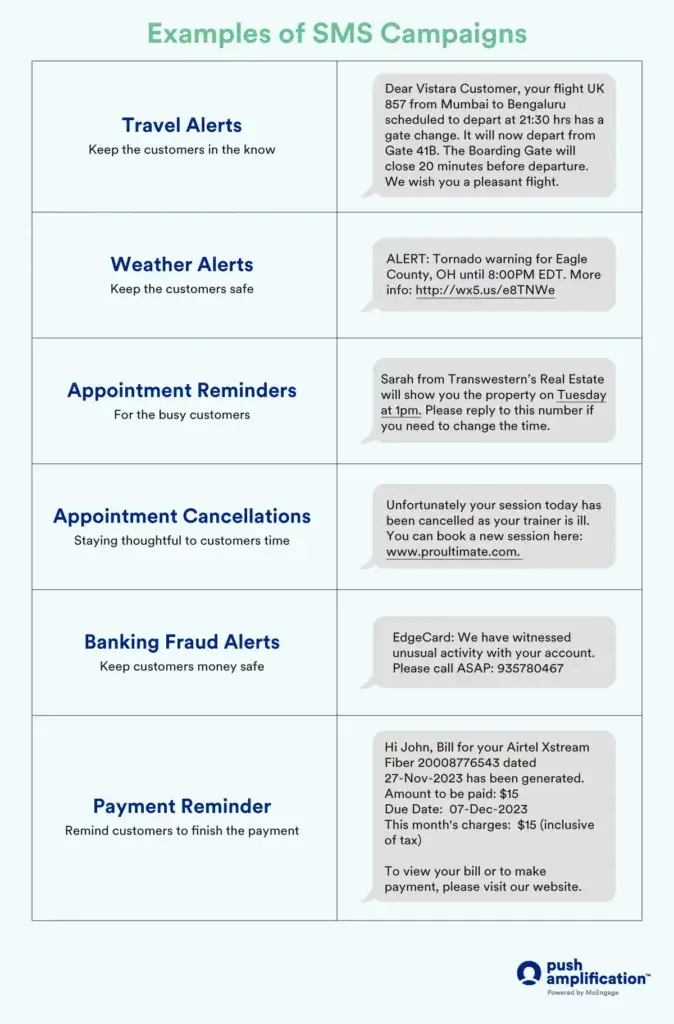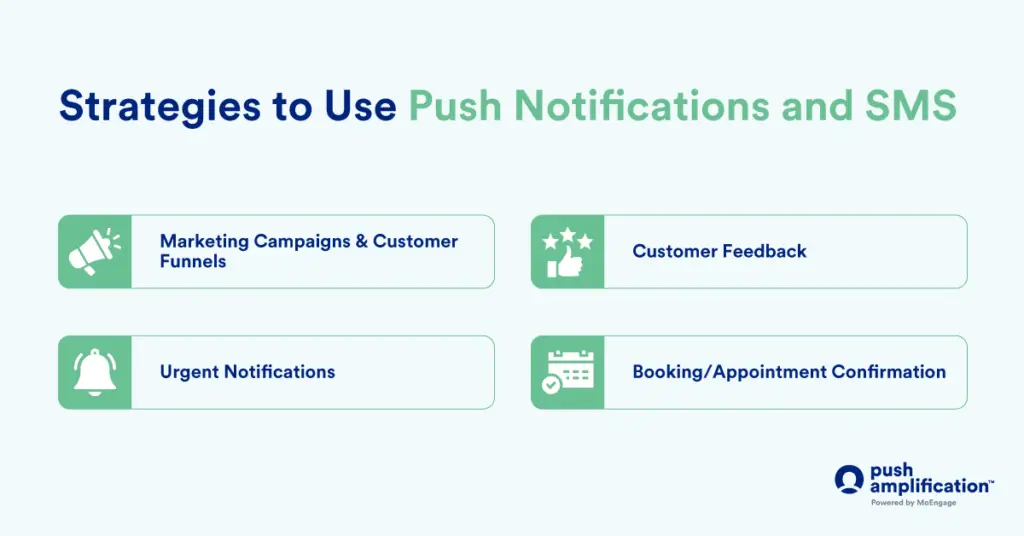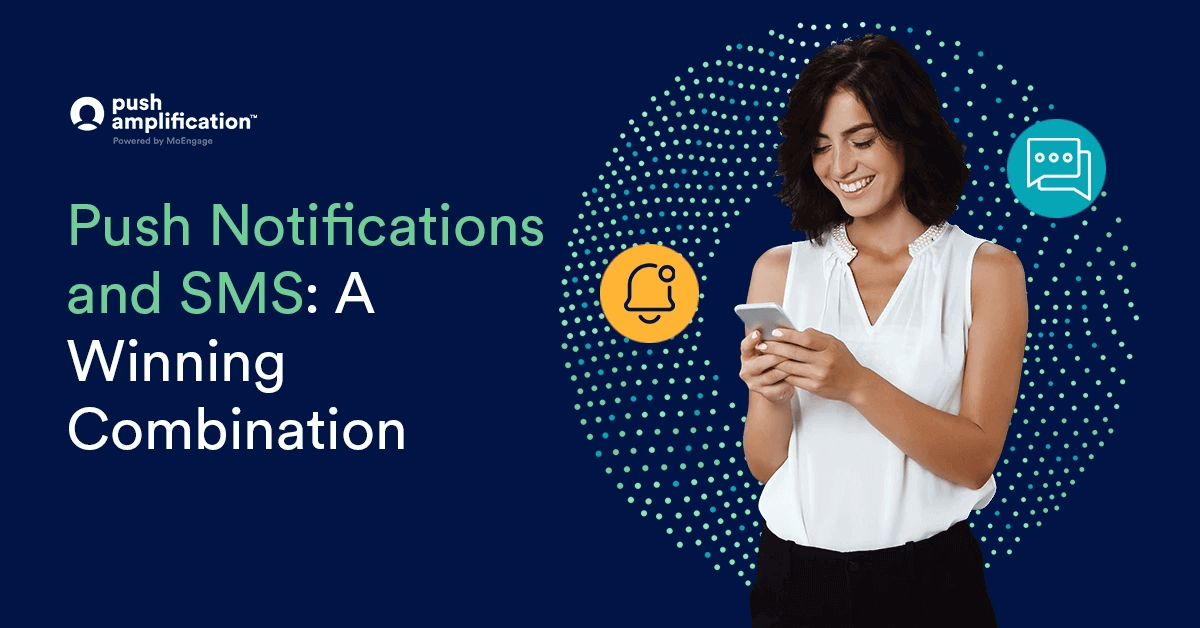The average consumer checks their phone 96 times daily (or once every 10–12 minutes)! If you want to guarantee your customers receive your message quickly and securely, channels including SMS and push notifications are your best bet.
SMS messages are delivered directly to the recipient’s mobile device through the cellular network. This direct delivery ensures that messages are received almost instantly, making it reliable for time-sensitive information.
Push notifications, however, are sent directly to the customer’s device. They can be delivered even if the customer is not using the app.
Both methods allow direct access to customers’ cell phones, but both have pros and cons. Which should you use and when? Is it better to use SMS, push notifications, or a combination?
Let’s understand this briefly in our article.
Push Notification vs SMS
The main distinctions between push notifications vs SMS are their opt-in processes, engagement mechanism, customer control, and delivery methods. SMS relies on consumers providing their phone number or sending a specific code for opt-in.
In contrast, push notifications require consumers to download an app and explicitly confirm their desire to receive notifications.
Additionally, push notifications often require internet connectivity, whereas SMS messages rely on cellular networks. The choice between push and SMS depends on factors such as content type, customer interaction, and the desired reach of the communication. Let’s look at the characteristics and differences between Push notifications and SMS in the table below –
| Category | SMS | Push Notifications |
| Opt-in | Customers can opt-in by entering their phone number or texting a code. | Customers opt-in when they permit to receive notifications after downloading the application. |
| Visibility | SMS messages stay at the top of phones, separate from push notifications. | Push notifications can appear as banners, badges, announcements, or sounds. They may appear individually or stacked with other notifications. |
| Engagement | Consumers can read, click links, or respond with a text. | Consumers click a push notification to access the application. |
| Customer preferences | Consumers have limited control over text message preferences. | Consumers have greater control over message preferences, delivery, and appearance on their devices. |
| Delivery method | Messages are delivered over a cellular network to the mobile phone. | Push notifications are delivered from a downloaded app to the mobile phone. |
Strategies to Leverage Push Notifications
Push notifications should be used when your communication requires timely updates on non-critical matters, such as product updates, new features, reminders, feedback requests, customer-triggered events, or promotional messages.
Push notifications, although not as urgent as SMS, offer a less intrusive way to engage consumers and are more likely to be opted into. They are particularly effective for information that demands little attention but benefits from periodic reminders or updates.
Additionally, push notifications allow more flexibility for consumers to manage preferences within an app, making them a preferred choice for non-urgent yet valuable communications. Here are instances where sending a push notification is typically advantageous:
- Product updates
- Introduction of new features
- Reminders
- Requests for feedback
- Triggers specified by consumers
- Announcements of sales and discounts
While push notifications may lack the urgency and visibility of text messages, they still attract attention and open. Being less intrusive than SMS, consumers are more inclined to opt into this messaging channel.
Conversely, precision is crucial for text message campaigns, as missteps may lead to customer unsubscribing. This is not always the case with push notifications—consumers might not immediately disable all notifications if they find them less helpful; instead, they might temporarily ignore them or adjust their preferences within your app.

Strategies to Leverage SMS
Determining whether SMS or push notifications are more suitable for your message depends largely on your target audience, industry, and product. However, there are specific scenarios where using SMS is generally advisable:
- Urgent communications
- Travel alerts
- Delivery updates
- Confirmation messages
- Appointment reminders
- Fraud alerts
- Marketing messages
In essence, when time sensitivity is crucial, opting for SMS is typically preferable over using push notifications.
Obtaining customers’ phone numbers is more guarded and selective than email addresses. However, consumers are generally more willing to download apps, especially if they are free. On average, individuals have around 40 apps installed on their phones, which can send messages to consumers if notifications are enabled.

Strategies to Leverage Push Notifications and SMS
The choice between push notification and SMS isn’t always an either-or scenario. Sometimes, it’s advantageous to use both channels—just not simultaneously. By combining SMS and push notifications, you can optimize your campaigns, ensuring your messages are seen and providing your audience with opportunities to engage.
- Marketing Campaigns: If you’re looking to communicate periodic updates on recent campaigns, product launches, or ongoing sales, consider employing both text and push notifications. While text messages can redirect consumers to your website’s E-commerce store, push notifications have the advantage of directing them within the app.
Imagine a retail company implementing a multichannel communication strategy using both push notifications and SMS. When a customer signs up for the app, they receive a personalized welcome push notification, introducing them to the app’s features. A few days later, the company notices the customer has added items to their cart but hasn’t checked out. They send a push notification with a limited-time discount offer. However, knowing that the customer might have disabled push notifications or might not be actively using the app, they also send an SMS with the same discount code and a reminder about the items in the cart.
The combination of push notification and SMS increases the chances of the customer engaging with the offer, providing a seamless experience across multiple channels and ultimately leading to a successful purchase.
- Urgent Messages – When immediate communication is essential for matters such as fraud alerts, travel updates, or canceled appointments, initiate contact with an SMS first, and then follow up with a subsequent push notification.
- Account Information – For tasks like prompting customers to update billing or shipping information, start with a push notification. If timely action is not taken, a follow-up text can be sent.
- Customer Feedback – To solicit feedback on a product, service, or overall experience, use a push notification initially, and if there’s no response, follow up with a text at a later time.
- Appointment Confirmation – Streamline appointment confirmations by prompting customers to confirm within the app. In case of delayed responses, a follow-up text can be sent.

Now that you know the advantages and limitations of both channels, you can find the technique that ticks with your audiences and harness it to your strengths! For best results, it is always wise to strike a balance of multi-channel marketing tactics for long-term engagement, higher conversion, and improved retention rates.
To improve push notification delivery rates, MoEngage has launched Push Amplification. Push Amplification™ Plus operates by obtaining exclusive authorization to send Push Notifications via the customer’s device push service channel.
About MoEngage Push Amplification™ Plus
MoEngage is a customer engagement platform driven by insights, designed to empower marketers and product owners with AI-driven analytics for crafting beloved omnichannel experiences.
MoEngage’s unique Push Amplification™ Plus technology surpasses these constraints, allowing you to engage with a broader audience.
Here is how Push Amplification™ works:
- Recognizing undelivered Push Notifications on your customer’s device,
- Serving as a backup system for Firebase Cloud Messaging (FCM), and
- Delivering those pending Push Notifications directly to customers’ devices.
- This significantly improves the overall success rate of delivering your Push Notifications.
To know more about MoEngage’s Push Amplification™ technology, contact our team of experts today!

